1902 Search Results for video of the week
April 24, 2016
by Carole Zangari -
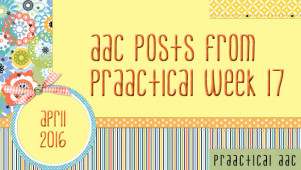
It’s been a busy week of AAC. Monday – AAC & ASD: Teaching Communication Partners Through Video Modeling Wednesday – Video of the Week: Getting Started with AAC for Parents & Practitioners Friday – PrAACtically Pinteresting with Lauren Enders: Writing AAC Goals & Objectives
April 18, 2016
by Carole Zangari -
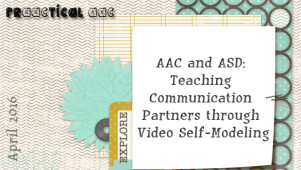
It is an honor to have Dr. Joanne Cafiero, an AAC consultant for individuals with complex communication needs and Autism Spectrum Disorders, as a guest contributor for today’s post. Dr. Cafiero is the author of Meaningful Exchanges for People with Autism an Introduction to AAC (2005). She is a consulting editor for Focus on Autism and Other Developmental Disabilities and has guest edited several of ASHA’s Perspectives in AAC. She was a member of the National Academy of Sciences Committee on Educational Interventions for Children with Autism (2001) and is currently working on an update on AAC and Autism for the Academy. In this post, she shares some of her work on video self-modeling. ::::::::::::::::::::::::::::::::::::::::::::::::: Growing research and first-person reports are illuminating the unique sensory and motor differences experienced by people on the Autism Spectrum. This new information has a huge impact on the AAC practitioner. Motor planning differences in ASD can... [Read More...]
April 17, 2016
by Carole Zangari -
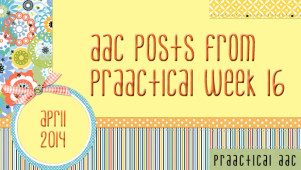
AAC posts you may have missed in your busy week. Monday – PrAACtical Resources: Video Examples of Aided Language Input Wednesday – Visual Immersion Program Thursday – How We Do It: Controlled Practice with Partner Augmented Input
April 10, 2016
by Carole Zangari -
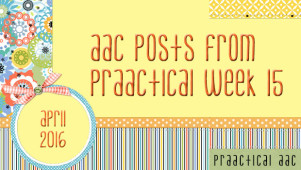
Had a busy week? Here are a few posts that you may have missed. Monday – PrAACtical Teaching in an ASD Classroom: Little Tips for Big Core Wednesday – Video of the Week: AAC at Home Thursday – Beyond Autism Awareness to Acceptance, Understanding and Inclusion
April 3, 2016
by Carole Zangari -
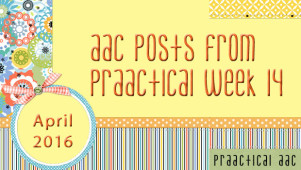
Hope you had a great start to Autism Awareness and Acceptance Month! Monday – PrAACtical Resources: Video Explainers for Aided Language Input Wednesday – Video of the Week: Getting Started with PODD Friday – PrAACtically April: Resources for a Year of Core Vocabulary Words
March 28, 2016
by Carole Zangari -
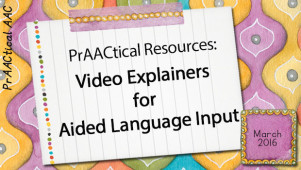
A growing number of clinicians, families, and educational teams are prioritizing the use of aided language input as a foundational strategy for AAC learners. When we first started writing about this strategy, it was rare to see adults using AAC to talk with AAC learners.Consistent implementation is still a challenge, but more and more of you are speaking AAC to teach AAC. And quite of few of you are doing your best to influence other stakeholders to support augmented communicators in this way. If you are doing inservices, teaching classes, or guiding teams toward better AAC intervention, the videos listed below may be useful to you in those efforts. Chris Bugaj developed this clear and engaging cartoon explaining the concept for people new to this strategy. Caroline Musselwhite recorded a full webinar with detailed information on aided language input. Communicare, a clinical practice with a strong focus on AAC,... [Read More...]
March 27, 2016
by Carole Zangari -
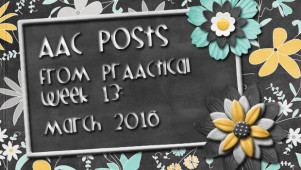
Happy Sunday, prAACtical friends. Hope you’re taking some time to recharge, Monday – PrAACtically Pinteresting with Lauren Enders: AAC Video Examples Wednesday – Video of the Week: Boosting Communication with Video Modeling Thursday – PrAACtically Reading with Karen Natoci: April Fool’s Day Above everything else, AAC is a person’s communication tool. If it’s not always available, it’s not AAC.
March 20, 2016
by Carole Zangari -
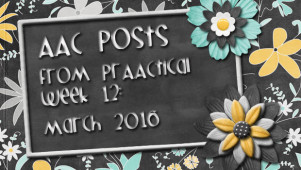
Hope your prAACtical week was productive and satisfying. Monday – PrAACtical Teaching in the ASD Classroom: Bigger is Better with Core Vocabulary Wednesday – Video of the Week: Building Linguistic Fluency with AAC Learners Thursday – AAC Assessment Corner with Vicki Clarke: Is Feature Matching Still Relevant?
March 13, 2016
by Carole Zangari -
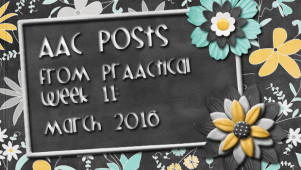
Let’s make this a great week for AAC collaboration, support, and sharing. Monday – PrAACtical Site of the Month: Loudoun County Public Schools AT Team Wednesday – Video of the Week: Infusing AAC Core Vocabulary into Interactive Storybook Reading Thursday – Learning About Augmentative Communication Empowerment and Support (ACES)
March 6, 2016
by Carole Zangari -
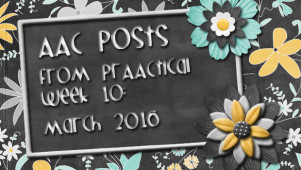
Hope you’ve had a productive week of AAC teaching and learning. Monday – PrAACtically March: AAC Core Vocabulary Resources Wednesday – Video of the Week: Scaffoldingand Anchoring Thursday – PrAACtical Resources: AAC Partner Strategies Handout Not too old, not too young. Not too intellectually impaired or gifted. Not too motorically limited or talented. Everyone deserves a voice.









